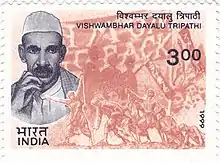Vishwambhar Dayalu Tripathi
Vishwambhar Dayalu Tripathi (5 October 1899 – 18 November 1959) was an Indian lawyer and politician.
Vishwambhar Dayalu Tripathi | |
|---|---|
 Tripathi on a 1999 stamp of India | |
| Member of Parliament, Lok Sabha | |
| In office 1952 - 1960 | |
| Personal details | |
| Born | 5 October 1899 |
| Died | 18 November 1959 |
| Political party | Indian National Congress |
| Alma mater | University of Lucknow |
Early life
He was born at Bangarmau in Unnao District in what is now the Indian state of Uttar Pradesh. He had a brilliant academic career, with an MA (History) and an LLB (Gold Medal) and gave up his studies in response to the call of the Indian National Congress.
Politics
He plunged into politics and devoted his life to the nation. He became the leading political figure in his district and soon became one of the most popular leaders in the state and beyond.
When the Non-Cooperation Movement was suspended, he returned to University and took his degree in 1924. He attended both MA and LLB classes at Lucknow University. After completing the two degrees in 1926, he was awarded a fellowship to do research in ancient Indian history, but political activities prevented him from continuing.
He joined the Unnao Bar in 1926, and soon won laurels in his profession in spite of spending most of his time for Congress work.
Prison
In 1930, he joined the movement against the British decision to impose tax on salt production. He was jailed. Hardly had he come out of prison than he was again arrested. He gave his own house for Congress work where he lived and a Congress office, and an ashram also functioned.
He was released in 1932 and became Dictator (organisational post in the Indian National Congress) of the United Provinces. On 2 July, he was arrested again and sentenced to one year in jail. On his release, he founded a farmers' organisation. Once again, he was sentenced to a year in jail for calling for non-payment of rent, but the sentence was quashed by the High Court.
On April 19, 1942, he was again arrested along with his younger brother Bal Ganga Dhar Tripathi (1917-1991), and remained incarcerated till December 2, 1945, at Fatehgarh Central Jail
Independence struggle
Vishwambhar Dayalu Tripathi was always in the forefront of the Indian independence struggle. He had a record of seven convictions for his political work.
In 1921, he first became a member of the Provincial Congress Committee. From 1921 to 1926, he was Secretary of the Unnao District Congress Committee and then became its President. He was Chairman of the Reception Committee of the Provincial Congress held at Unnao in 1936. He was also a member of the All India Congress Committee.
He represented Unnao-Safipur constituency in the Provincial Assembly of the United Provinces and served as a member of the Agrarian Committee appointed by the Provincial Government to revise the existing rent and revenue policy.
Vishwambhar Dayalu Tripathi was a close associate of Subhas Chandra Bose. When Bose resigned as President of the Indian National Congress to form the Forward Bloc in 1939, Bose was its founding President, and Vishwambhar Dayalu Tripathi its founding Secretary.
Positions
Among the other positions he held were:
- Chairman of a Commission which was sent to the Andman & Nicobar to assess the possibility of development on the islands
- Chairman of the Zamindari Abolition Commission
- Chairman of the Recognition Committee of the UP High School & Intermediate Board of Education
- Founder of DSN College, Unnao, and many other educational institutions
Assembly
In 1946, Vishwambhar Dayalu Tripathi was elected to the Constituent Assembly that gave India its post-independence constitution. He was elected to the 1st and 2nd Lok Sabha in 1952 and 1957 from Unnao constituency in Uttar Pradesh. He died on 18 November 1959.
References
External links
- Kamat Research Database
- Unnao District
- Gallery of Indian Autographs
- 1. Bal Ganga Dhar Tripathi, “Mere Da”, Apraje Purusharth Ke Dhani Jan Nayak Pandit Vishwambhar Dayalu Tripathi Smriti Granth (Unnao, Uttar Pradesh: Vishwambhar Dayalu Tripathi Smarak Samiti, 2008), pp. 257-258.